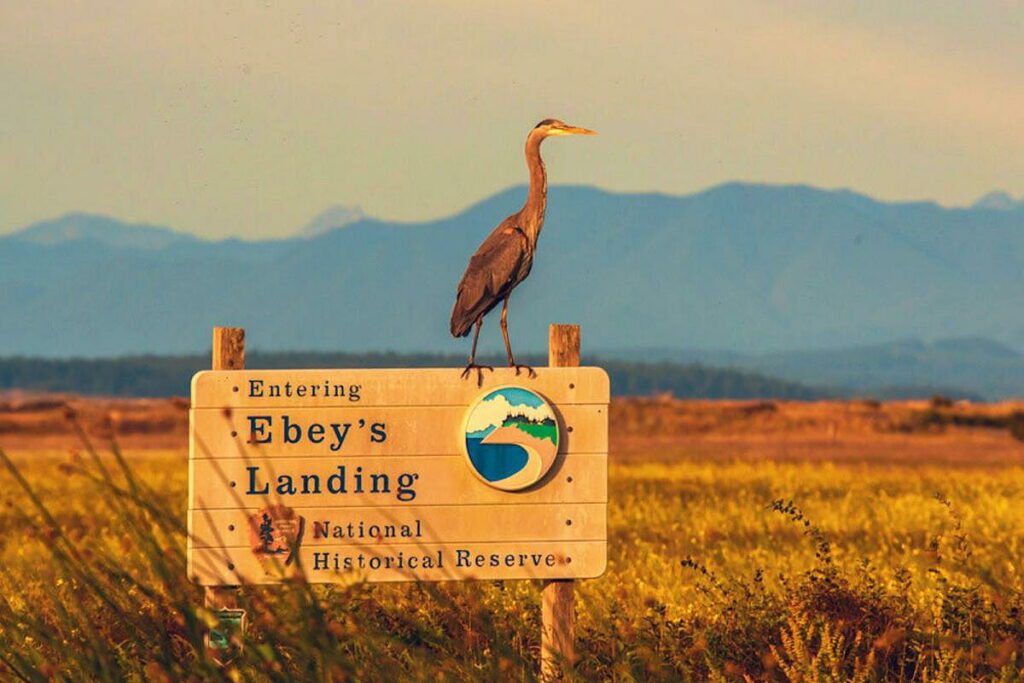Ebey’s Landing is a historically significant area located on Whidbey Island in Washington State, known for its stunning landscapes, rich cultural heritage, and unique blend of natural beauty and agricultural history. The area is part of the Ebey’s Landing National Historical Reserve, which was established in 1978 to protect the cultural and natural resources that reflect the early history of the Puget Sound region.
Early Indigenous Inhabitants
Long before European settlers arrived, the region around Ebey’s Landing was inhabited by the Lower Skagit, Snohomish, and other Coast Salish peoples. These Native communities lived in harmony with the land and relied on the abundant natural resources of the area, including salmon fishing, shellfish harvesting, and plant gathering. The shoreline, prairies, and forests of Ebey’s Landing were central to their seasonal cycles of resource gathering and trade.
Arrival of European Settlers
Ebey’s Landing gets its name from Isaac Neff Ebey, one of the first American settlers to establish a permanent homestead in the Puget Sound region. In 1850, Ebey, originally from Missouri, arrived on Whidbey Island after hearing about the fertile land and economic opportunities. Drawn by the promise of free land under the Donation Land Claim Act, which offered settlers large parcels of property, Ebey claimed a vast section of the island.
Ebey’s Landing / Getty / Canva
Ebey’s Landing / Getty / CanvaEbey’s Landing
Isaac Ebey recognized the strategic importance of his new homestead. Its location on the bluffs overlooking Admiralty Inlet offered expansive views of incoming ships, and the fertile prairie land made it ideal for farming. Ebey quickly established a successful farm, growing wheat and other crops that supplied the growing populations in nearby towns like Seattle.
Ebey’s Legacy and Tragic Death
Isaac Ebey played an important role in the early development of the Puget Sound region. He was a prominent figure in local politics, serving as a customs agent and later as a representative in the territorial legislature. However, his life was tragically cut short in 1857 when he was murdered by Haida raiders from British Columbia. The raid was part of a retaliatory action for the killing of a Haida chief by American forces, though Isaac Ebey had no direct involvement. His death left a lasting impact on the local community and added a somber chapter to the history of the area.
The Birth of the Ebey’s Landing National Historical Reserve
What makes Ebey’s Landing unique is its designation as a National Historical Reserve—this status reflects the area’s dedication to preserving both the natural landscapes and the cultural history. The reserve, established in 1978, encompasses more than 17,000 acres, including prairies, forests, farms, and historic settlements. Unlike many national parks, Ebey’s Landing is a living landscape, where private landowners continue to farm and manage the land as they have for generations.
Ebey’s Landing / Getty / Canva
Ebey’s Landing / Getty / CanvaEbey’s Landing
The reserve includes several historic buildings, such as Jacob Ebey’s house (Isaac’s father) and the historic town of Coupeville, which was one of Washington’s first European settlements. Coupeville’s charming waterfront, historic architecture, and proximity to Ebey’s Landing make it a popular destination for visitors exploring the reserve.
Scenic and Cultural Significance Today
Today, Ebey’s Landing is a beloved destination for nature enthusiasts and history buffs alike. The Ebey’s Landing Trail offers stunning views of the shoreline, prairie, and surrounding farmland, while the nearby bluffs provide a dramatic backdrop for hiking and photography. The area serves as a reminder of the enduring legacy of settlers like Isaac Ebey and the long-standing connection between people and the land.
The agricultural heritage of the area continues to thrive, with many local farms contributing to Washington’s sustainable farming movement. The reserve also preserves the natural beauty of the region, protecting wildlife habitats and offering a window into the way life once was on Whidbey Island.
In short, Ebey’s Landing stands as a testament to the blending of history, culture, and nature, showcasing the layered stories of Native peoples, European settlers, and the ongoing stewardship of the land by its current residents.
LOOK: Stunning vintage photos capture the beauty of America’s national parks
Today these parks are located throughout the country in 25 states and the U.S. Virgin Islands. The land encompassing them was either purchased or donated, though much of it had been inhabited by native people for thousands of years before the founding of the United States. These areas are protected and revered as educational resources about the natural world, and as spaces for exploration.
Keep scrolling for 50 vintage photos that show the beauty of America’s national parks.
Gallery Credit: Alexander Raeburn
Source link : http://www.bing.com/news/apiclick.aspx?ref=FexRss&aid=&tid=670843d02a144ea1b8d49042c12ff6a5&url=https%3A%2F%2F610kona.com%2Fhistory-puget-sound-washington%2F&c=666258220548829352&mkt=en-us
Author :
Publish date : 2024-10-10 10:12:00
Copyright for syndicated content belongs to the linked Source.
